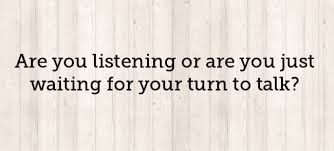Think about the last time you were in front of a customer trying to have a great meeting. You felt it was going well and you were asking great questions. In return, the customer was giving you some really good info. Were you really listening hard to what the customer was saying or were you really focused on trying to figure out what to say or ask next?
This is really important. Old style sales techniques of showing up and telling the customer how wonderful your company and products and services are just not working anymore. Everyone is teaching that to build a relationship you need to have a genuine or authentic interest in your customers and their problems. The best way to do this is to ask lots of questions – how is that working for YOU?
To Do or Not To Do to have a Great Meeting
This can be a double edged sword. To get the appointment is hard enough. Now you have to figure out if there is a viable opportunity to go after. You may only get one shot to make an impression. You feel compelled to tell them about you. At the same time customers are typically okay to answer a couple questions. They do not want to spend their time telling you stuff they believe you should already know. Hence the conundrum; ask too many questions and be seen as not knowing anything about their business or show up and throw up (metaphorically) and totally turn them off never to hear from them again.
New Approach to a Great Meeting
In an earlier Blog post I talked about the importance of being CURIOUS. Having done your preparation and research for this meeting, you can formulate a couple of really good penetrating questions that show the customer you truly are curious. Here is the key – actually focus totally on what they are saying. Get permission to take a few notes and jot down a few to show you are really listening. Probe a bit. If they suggest they are having an issue with X or Y, ask something like ‘How is that affecting your ability to deliver to your customers or stakeholders?”
Your goal with your questions should be to bring the issue or problem from a high level right down to how it affects them. What would it mean to them if you could help them out? Make it personal. At this point you are not trying to insert anything about what you do or offer – you are simply listening and learning.

When you feel the customer has said pretty much all they are going to at this point on this issue or problem try something like this. “Well Bill, thanks for sharing all that. Now I want to make sure I really heard you correctly and understand the problem. Let me repeat it back and please jump in and correct me if necessary.”
After Bill picks himself up off the floor… and confirms you have it right your next question should be “Bill, this has been very useful for me. I have a couple ideas about how I might be able to help you. Would you like to learn more right now?” Doing it this way sets the initial hook and you have permission to tell your ‘story’. Be careful though to stay on track and consistent with the issue or problem at hand. Going off on tangents and talking about your full range of products and services will likely undo all the great work you have done so far.
Simple or Easy?
This is not easy to do. It takes a lot of discipline and practice. It requires you likely break from what you typically do and undoing habits to create new ones is incredibly tough. The great part of this is it can have a massive impact on the quality of the relationship you create and what that means over the long term for business.
So work real hard at really listening in your next customer meeting and see the results for yourself.
Have a great week but before you go be sure to check out my online courses at https://www.takeactionsalesacademy.com
Also get my Daily 2 Minute Leadership and Sales Thought videos on my Facebook page at
https://www.facebook.com/takeactionsalesacademy
